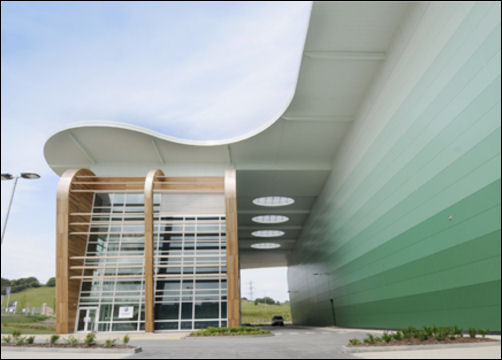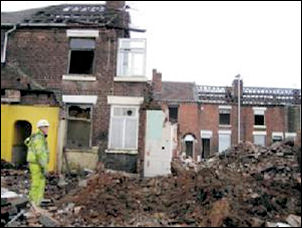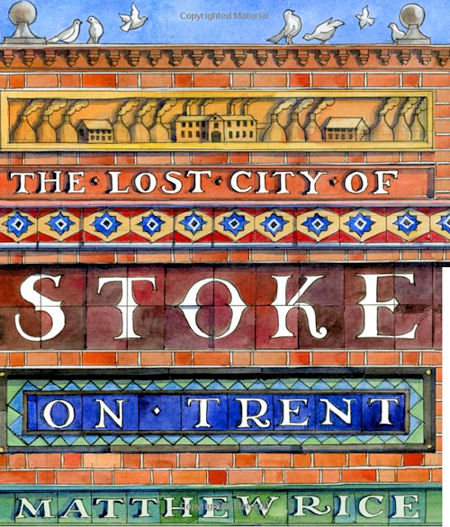|
One of the few new build projects of note was led by Newcastle-under-Lyme Borough Council on the site of a former colliery in Chatterley Valley to the north of the city – Blue Planet, a new distribution centre, and one of the most sustainable new buildings in the city, possibly the country. The building was completed over a year ago, but unfortunately, it still lies empty, probably due to State of the Market.

Artist's Impression
of Blue Planet

Blue Planet - the
finished article
©Urban Vision North Staffordshire
And so there we have
what could potentially be the Legacy of the 00’s, the potential Legacy of what may have been the Regeneration Years.
Aside from Blue Planet, the one thing that binds the projects highlighted is reuse and restoration. As laboured previously in these pages, and highlighted above: There Is Another Way.
However, the positives of the past decade or so have been outweighed by the negatives. There has been far too much emphasis on clearance and demolition, of housing, and of other important local buildings, such as potbanks and old schools.
This has led to a disillusioned and disenfranchised local population who believe that regeneration is just a game in which they are pawns. This is demonstrated by the recent vandalism on the new Bridgewater Bridge over the Caldon Canal in Hanley, a landmark in one of the city’s key projects, City Waterside.
It has also contributed enormously to the erosion of the character of the Potteries, and once where such buildings once stood, we now see ‘bombsites’ and dereliction. We will be told that these are future development sites which will aid the resurgence of the city. But will they?
I grew up in what I understand now was Renewal Area to the north of the city in Packmoor. The bottom half of my street was demolished in the mid-1980s; the said site is still vacant and covered in weeds some twenty-five years later.
Is this a picture of the future of the city’s ‘Areas of Major Intervention’? Places like Shelton, Hanley and Middleport have seen much demolition, and have been left in ruins. The thought that we have repeated the mistakes made in the street where I grew up, but on a Grand Scale, is terrifying.

Walls
Come Tumbling Down
©The Sentinel
The good news is that major figures in the regeneration industry recognise that towns and cities like Stoke-on-Trent will still need support in this new era of austerity, but as public finances get tighter and tighter, what will be the reality for Future Stoke?
There would appear to be little market interest, and as land values plummet in the city, you would assume that the Old Model will no longer work in any case. Have we missed the boat? We can only hope not.
As Matthew Rice has recently screamed: STOP! Now is the time to take stock. Mistakes have certainly been made. I have worked in housing and regeneration for almost a decade, and though I certainly don’t claim to be an expert, I have learned a lot during that time, and I have always believed that sustainable regeneration is underpinned by the history of a place: fail to understand a place, and you will fail to change that place for the better.
A change of attitude to Stoke-on-Trent’s past is needed before we can achieve the positive change that we are all striving for, and that needs to start at the top. I have sat in meetings in the past where our historic environment has been cursed by the very people who ought to be shouting loudest about it. How sad is that?

The Lost City of
Stoke-on-Trent

Matthew Rice
There are other ways, as Matthew Rice has pointed out in his excellent recent polemic on our great city ‘The Lost City of Stoke-on-Trent’. Regeneration in our city has been about demolition and clearance, and this has failed.
The Potteries has lost far too many buildings over the past decade; as Ian Nairn said in his foreword to Neville Malkin’s A Grand Tour, “eternal vigilance is the name of the game; making sure that good buildings of any age do not disappear through neglect or indifference. The Potteries has lost a lot of fine buildings since the war, through both causes: it cannot afford to lose any more”. Nairn’s words were written in 1976; they have as much – if not greater – meaning and importance today.
David
Proudlove
October 2010

|
![]()
![]()
![]()